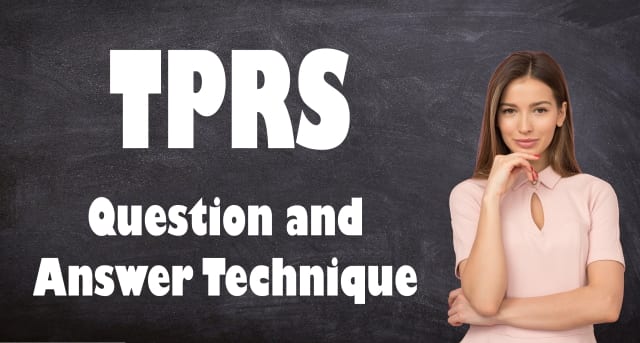How to use language shadowing or German shadowing + TPRS to become fluent
Introduction
Learning a new language is hard.
It’s like climbing a hill, but not just any hill.
The kind that is short enough that you can easily see the top, only that you walk and walk but you don’t seem to be getting any closer to finishing it.
So, most people give up.
But that’s maybe because they didn’t know about language shadowing and especially about German shadowing combined with the TPRS method…
What is language shadowing?
By the simplest definition, language shadowing is a technique for learning a language where a student listens to a recording in a target language and then speaks simultaneously as the recording plays.
However, this is not the same as repetition.
Repetition is where you speak after the recording has played, but shadowing is where you speak at the same time as the recording plays.
With the definition out of the way, here’s how to do it for best results.
How to practice language shadowing effectively
In my many years as a German teacher, I’ve come across many practices that work and those that almost work.
And I have experimented widely too – that’s how I came up with the TPRS (more on that later).
It is therefore from that kind of evaluation and experience that I am presenting you the most straightforward steps to language shadowing:
A. Select your recording
B. Ensure your recording is accompanied by written text with an English translation
C. Read the text in your target language then look at the translation
D. Listen to the audio in the target language as you read the text
E. Speak at the same time as the recording plays (language shadowing)
F. Listen without reading
G. Practice with the Question and Answer Technique (more on that later)
A. Select your recording
One thing to note is that you shouldn’t use just any recording.
The recording has to be funny, interactive and at your level of learning.
This is because when you read something funny your brain focuses more on that subject and because it’s interesting you don’t just listen attentively but you look forward to the next part.
This kind of anticipation carves more words into your memory than if you were listening to, say, a medical journal on protein synthesis or something that is outside your area of interest.
At the same time, selecting a recording that is not at your learning level is equally ineffective in the following ways:
a. If it’s too advanced, your brain will lock itself and you will get bored then start drifting off, wasting valuable time.
b. If it’s too easy, you will make little progress as you will already know what is being said and therefore you will again, waste time.
The key here is in finding a recording that is easy enough to understand but hard enough so that you can learn new words and pronunciations.
And that’s one of the reasons I created the TPRS recordings – so you never have to struggle finding learning material suited for your level. (You’ll find TPRS recordings below)
B. Ensure your recording is accompanied by written text with an English translation
“Most people do not listen with the intent to understand; they listen with the intent to reply.” ~ Stephen R. Covey
Most of the time, this is a bad thing.
Except when you are shadowing for language learning.
You want to reply to what you hear, so you just need to crank up what most people are hardwired to do.
But for this to be effective, your recording should be accompanied by written text with an English translation, so that you understand what you are hearing.
A key element in shadowing for language learning is that you need to understand what you are hearing.
You may download audio files or podcasts in your target language, but if you cannot understand fully what is being said then your language shadowing will be ineffective.
If you have to download an audio file, ensure it comes along with written text that has a translation. But if you don’t want to search for funny audio files that are at your level, don’t worry. I’ll show you what to do.
C. Read the text in your target language then look at the translation
Now you can start reading.
Ensure you begin with short phrases and then you can look at the translation afterwards.
Here is an excerpt from one of my German audio lessons for beginners. The individual lessons have different levels.
| German | English |
| das Auge / die Augen | the eye / the eyes |
| Du hast wunderschöne Augen. | You have wonderful eyes. |
| das Ohr / die Ohren | the ear / the ears |
| Peter hat große Ohren. | Peter has big ears. |
| der Arm / die Arme | the arm / the arms |
| Ich habe zwei starke Arme. | I have two strong arms. |
You don’t want to read very long sentences or else you will start getting confused and lose your flow.
Remember, the text is ideally simple but with some hard words so even if you find that you know most words, don’t fall for the temptation of going a step too far. You will start to get confused.
Just read bit by bit, looking up words that you may need to.
When you finish reading, repeat over and over again, this time covering longer phrases, but never too long. You will always know when it’s time to look up the translation.
| German | English |
| das Gesicht / die Gesichter | the face / the faces |
| Sie hatte einen leichten Sonnenbrand im Gesicht. ? | She got a slight sunburn in the face. |
This is an excerpt from one of my Audio TPRS lessons.
Click here >> TPRS (Vocabulary Lesson) if you want to practice with the full audio lesson.
D. Listen to the audio in the target language as you read the text
Listen to this excerpt from the TPRS for example:
Do not, however, pay too much attention to each individual sound in your recording.
Instead, give it a quick run to get a feel of the general soundscape of the words. The speech elements that you will start noticing will include stress points, accents and changes in intonation.
As you run this quick check, your brain will be registering the areas where a certain element is highlighted, and when you finish reading and start repeating, you will subconsciously pay closer attention to these areas.
Think of what happens when you watch a movie trailer…
You get to see the most interesting parts, and so when you start watching the movie you will be subconsciously looking for these parts.
That’s how a quick check primes you to know the interesting parts in a recording and know where to pay attention when you start listening keenly.
You can work with several texts or alternate texts at a time even as a beginner, and you will be able to increase your scope as you advance.
Do not, however, forget to evaluate your improvement from time.
If you choose to use the TPRS method, I will be sending you quizzes and lessons every now and then so that you can evaluate your progress, and you can always reach out to me if you get stuck or have questions.
E. Speak at the same time as the recording plays (language shadowing)
Now you’ve gotten the hang of it.
You understand the recording like your lines in a movie script and the director has given the go.

Only that you are at home and doing some not-so-heart-warming task.
All you have to do now is listen and speak as the recording plays. This shouldn’t be difficult, and the only challenge may perhaps be the speed of the recording.
If your recording is too fast, you need to find one that runs at a moderate speed. That’s in addition to being at your level and with short phrases.
Yeah, too much to look for…
That’s why I want you to try this lesson and see if it’s right for you:
>> TPRS (Vocabulary Lesson – Beginner Level)
If you need to read along, don’t worry. You will get to download a full lesson set complete with translated text when you sign up for my free German course.
At this point, when you start speaking simultaneously, you will need to ‘lock in’ on your narrator’s voice.
You don’t want to wait for a sentence or a phrase to end before repeating it – you need to follow as closely and as concurrently as possible.
Mumble if you have to, but whatever you do don’t go silent.
This is because if you get to a phrase you don’t understand and keep quiet, you will still be silent when the narrator reaches the parts that you understand, and you may not continue shadowing, or you will keep breaking your sentences and this is counter-productive.
F. Listen without reading
Now you need to listen only.
Put away the written text and do not bother to speak.
In the movie world, this is like the editing phase – it’s where you realize what you missed, mispronounced or didn’t understand.
It’s where you look up alternative words to some of the words you heard or maybe if you want to understand them in a broader context.
For instance, this is where you would look up why the narrator e.g. used wenn and not als, or dann and not denn.
By the way, you can see the differences, and how to use each here: als vs wenn
and here dann vs denn.
G. Practice with the Question and Answer Technique
You’ve been hearing about the TPRS since you began reading this text.
And it probably bothered you that I kept talking about something you didn’t know about.
Or maybe not.
TPRS means: Teaching Proficiency Through Reading and Storytelling.
This method mainly uses short situations or whole stories that the student can easily imagine. So the learning material can be stored much better in the memory.
This method also includes a special “Question and Answer Technique” that will help you speak and think in German from the start.
Even beginners can use this technique right away.
Thinking in German is key if you want to become fluent, and the TPRS method trains you to think in German so that you understand the language without learning the rules by heart.
So how do you practice German shadowing with the TPRS?
To begin with, the TPRS offers all you need:
- Printable English translation (for understanding)
- Recorded native speaker (for pronunciation)
- Written words (for spelling)
That means you get all the necessary items for German shadowing, and there are multiple levels of learning to cater for everyone from beginner to advanced learners.
Things to do while shadowing
Involve another activity
This is important because when you do other things your brain is more active and so you will focus more on what you are hearing. You will also get to ‘feel’ the language more, other than simply hear it. You could practice shadowing when walking, cooking, jogging etc.
Maintain an upright posture
Maintaining an upright posture increases oxygen intake which is important for the brain and thus improves your learning.
Speak loudly and clearly
When you speak loudly, you are basically tricking your brain to think that what you are saying is important and so it will pay more attention to that.
Benefits of shadowing for language learning
1. The main benefit…
…of the shadowing language learning technique comes down to pronunciation.
In English, an apple will mean the same thing regardless of how you pronounce it.
But in a language like Chinese for instance, the same word will have a different meaning if you pronounce it differently – you only develop such subtle differences when you shadow.
Remember, communication is a lot more than knowing the words. It’s about knowing how to pronounce them right.
2. The other benefit…
…is that you get to develop the natural melody of your target language, which means that you develop your target language’s intonation naturally.
Just as you learned your native language, intonation will gradually develop as you listen and repeat (simultaneously) what you hear other people say.
In short, when you shadow a native speaker, you are able to place emphasis or weight on certain syllables, and as a result you sound more natural when you speak.
But are there downsides to shadowing?
Watch out! – What you should know before you start – the disadvantage of language shadowing
The biggest shortcoming of shadowing is that pronunciation mistakes may become ingrained in your brain.
But how is this possible if you are listening to a native speaker?
In the likely event that the recording is not entirely clear, or maybe if it’s too fast, you may mishear certain words and so you will produce the nearest familiar sound in a language you are familiar with.
When you do this, you will continually use the sound value you attached to the syllable, which means that you will keep repeating the wrong pronouncing it every time you come across that syllable.
And when an error has been recorded in your long-term memory, it is very hard to correct it.
You have to get it right from the start.
But how do you do that, especially since mishearing is not your fault?
How to avoid the biggest disadvantage of shadowing
It all comes down to your source materials – the speed of recording, clarity of the voice, selection of vocabulary, length of the phrases, subdivision of the phrases, etc. – it all has to be right.
So you don’t just use any material.
Moreover, the best learning materials should also provide corrective feedback.
Unfortunately, most materials will not provide this, and so you will not know when you are making a mistake.
…unless if you are using the Question and Answer Technique of the TPRS.
This is because it has pauses after a question giving you time to answer and after you listen to the answer then you can correct any mistake you may have committed, especially in pronunciation.
And that leaves no room for your brain to store errors.
But how do you know it’s time to stop?
This is when you stop to shadow
You don’t want to repeat the same sentences until you become blue in the face, do you?
When you find that you can follow the recording at the same speed and understand everything, then it’s time to move on.
Obviously, this will differ from one learner to another, but a general rule of thumb is that you aim to understand about 80% with ease.
From the many years I’ve been teaching German, I realized that those who aim to understand about 80% of the lessons generally become fluent faster, because this percentage covers most of what you need in normal daily conversations.
Now you know all about language shadowing. If you have any question, don’t hesitate to contact me.
And if you are looking for other effective methods to learn German ← Check out this guide.
A quick recap on the shadowing language learning technique combined with the TPRS method
So, you don’t forget, here’s a quick run of what you’ve just read:
- Select a recording that is accompanied by a written translation in English
- Read the text and look at the translation
- Listen to the audio in the target language as you read the translation
- Speak at the same time as the recording plays (language shadowing)
- Practice with the Question and Answer Technique
While you are shadowing, don’t forget to:
- Involve another activity
- Maintain an upright posture
- Speak loudly and clearly
The main benefits of shadowing are that it:
- Teaches you to pronounce words properly by understanding existing subtle differences.
- Helps you develop the natural melody of your target language.
However, you may end up storing errors in your brain if you don’t hear certain words properly.
You avoid this by using learning material that has the right:
- Speed of recording
- Clarity of voice
- Length of phrases
- Subdivision of phrases, etc.
And most importantly, it should have corrective feedback.
You cannot go wrong that way, and few materials will check all those boxes, that’s why I recommend the TPRS method.
Besides, 80% of my students have used it in my course to become fluent in German in 6 – 8 months.
This is not a traditional course, and you will start with an adventure of collecting hidden codes which you will use to download a full lesson set at the end.
It’s fun and many students love it.

LGE Premium
Learn to speak German fluently in no time! 🚀
The story-based method helps you absorb grammar and vocabulary naturally.
👉 Don’t miss this limited-time offer!
Happy Email Subscribers
%
... reach confident speaking level within a few months
German teacher with 14 years of experience
Share the knowledge …
… with your friends and classmates.
Use the social media buttons. 👍






